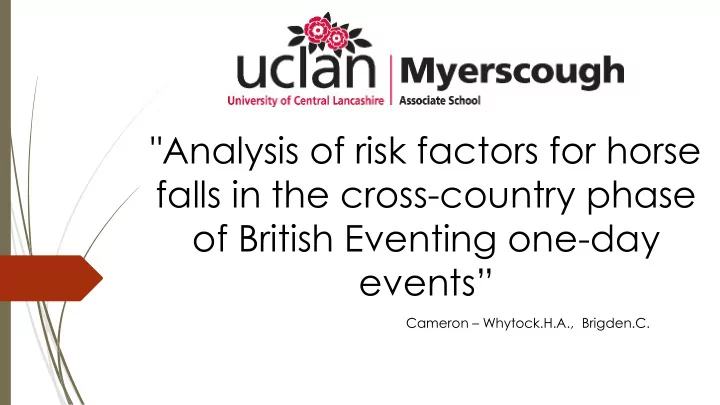

"Analysis of risk factors for horse falls in the cross-country phase of British Eventing one-day events” Cameron – Whytock.H.A., Brigden.C.
Introduction At ISES 2008, Eric Smiley posed the question of the future security of eventing as a sport, proposing that riders need to take more responsibility for themselves. Capt Mark Philips echoed these comments following the death of two event riders last year. Several risk factors associated with horse falls on the cross country phase of eventing have already been identified, although to date, there has been insufficient research into eventing safety. FEI President, Princess Haya Bint Al Hussein (2008) “The International Olympic Committee has very reasonable and legitimate concerns about eventing safety,” “Walking away and saying ‘Thank God nobody died,’ isn’t good enough.”
Horse Fall • Horse Fall defined by British Eventing as: “both the horses shoulder and its quarters coming into contact with either the ground, or the obstacle and the ground, simultaneously” • Developments were made to reduce horse falls after rider deaths in Britain: - frangible Pins - increased minimum qualification requirements - possible rider licensing • 36% risk of a serious/fatal outcome to a rider that is involved in a horse fall • 32% risk of injury to a horse involved in a horse fall (Murray., et al (2006)
Aims & Objectives Aims To analyse whether level of competition, horse age, horse gender, rider gender, position, month of competition, year of competition and event are factors that contribute to the risk of a horse fall during cross country. to establish public opinion of the main factors that increase the risk of a horse fall Objectives To collate substantial data regarding the occurrence of horse falls in eventing Model the relationship between factors identified and the probability of a horse fall Establish public opinion of what increases the risk of a horse fall
Factors • Novice • Level of Event • Intermediate • Horse Age • Advanced • Horse Sex • Rider Sex • Position Before Cross-Country • N = 2002 • Month of Event • Year of Event • Event
Methods Novice (1) Intermediate (2) Advanced (3) Position (Points awarded) (Points awarded) (Points awarded) 1 st 6 12 24 2 nd 5 10 22 3 rd 4 8 20 4 th (over 15 competitors) 3 6 18 5 th (over 19 competitors) 2 4 16 6 th (over 23 competitors) 1 2 14 7 th (over 27 competitors) 1 2 12 8 th (over 31 competitors) 1 2 19 9 th (over 35 competitors) 1 2 8 10 th (over 39 competitors) 1 2 8
Questionnaire
Results N 95% CI Lower 95% CI Upper G P D F Level 2002 0.69 1.15 0.744 1 0.388 Horse Age 2002 0.97 1.14 1.578 1 0.209 Horse Gender 2002 0.53 1.45 0.251 1 0.617 Rider Gender 2002 0.75 1.75 0.379 1 0.538 Position 2002 0.71 0.99 4.219 1 0.038 Month 2002 0.91 1.11 0.002 1 0.962 Year 2002 0.94 1.08 0.069 1 0.793 Event 2002 0.97 1.01 0.836 1 0.361
Results Significance level P<0.05 Group 2 = 0.49 less likely to fall (P Value = 0.028) Group 3 = 0.33 less likely to fall (P Value = 0.001) Group 4 = 0.46 less likely to fall (P Value = 0.016) Group 5 = 0.30 less likely to fall (P Value = 0.020) Significantly less likely to have a fall than group 1 (P<0.05) Group 6 = 0.83 less likely to fall (P Value = 0.718) Group 7 = 0.00 less likely to fall (P Value = 0.999)
Questionnaire Response n=131 61.83% riders 29.77% spectators 8.40% neither competitor nor spectators, 74.05% stated the main risk factor for a horse fall is rider error 64.88% stated the main risk factor as rider inexperience Speed also identified as a key risk by respondents Riders were significantly more likely to attribute horse falls to rider error than spectators ( χ ² 2 = 9.490, P<0.01).
Significant Factor: Position before cross – country Supporting Information - Top 3 placings Murray et al., (2005) N=720 Murray et al., (2006) N=676 Competitive riding Risk Homeostasis “ Relevant to people that partake in high risk sports have been said to be particularly susceptible to maintaining their level of risk.” (thrill seeking) (Wilde., 1982) Physiological demands of all 3 phases
In Discussion.. Vital supporting information of other studies Concealing scores until the end of competition? Riding ability Further studies into rider psychology (aggression, anxiety) – ineffectual styles of riding? Larger sample sizes
What does this mean? The project has answered a number of small questions, however, it has posed a number of fundamental questions… What would the effect be of concealing scores? Is ground condition / safety equipment use a factor? Would season-long performance influence this? The continuation of this project may highlight all of the significant factors behind injury risk. A management tool for governing bodies?
Future of the study Publication PhD Considerations: - Ground condition - Specific rider monitoring - Speed of approach - Safety equipment - Rider tendency to take risks - Psychological testing
Myerscough College Photo by – Joshua Thresh
Myerscough College - Facilities International Arena Horse walker Equine Hydrotherapy Spa Equine Solarium Science Labs HD Video equipment Video Analysis Software Statistics Software Yard with 60 horses Hay Steamer Equissage Zamar Machine (Leg cooling/heating system)
Myerscough Research RACES (Research and Consultancy in Equine Surfaces) Developed tests and assessed footing of surfaces for the showcase equestrian venue for the London Olympic Games 2012 Built a Biomechanical Hoof Tester – simulates the effect of a horse landing (at gallop) onto a surface (FEI recognised equipment for surface assessment) Lead authors for the FEI White Paper on Equestrian Surfaces Excellent track record racesresearch.org
Acknowledgements In Memory of Sean McGuinness 1989-2014 Robbie Whytock Myerscough/UCLan Jaime Martin, Sam Penrice
Recommend
More recommend